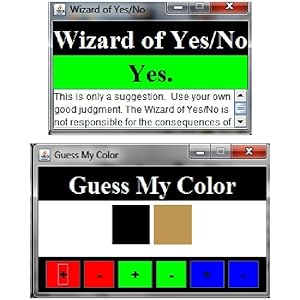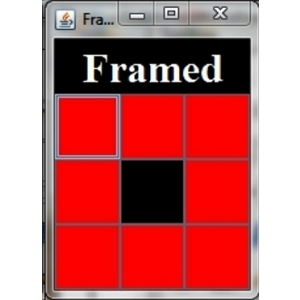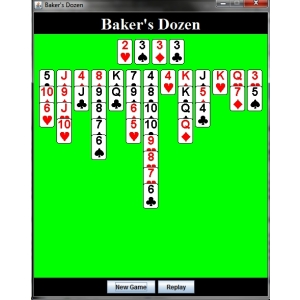
Price: $40.00
(as of Oct 11, 2024 12:59:43 UTC – Details)

More Do-It-Yourself Java Games: An Introduction to Java Graphics and Event-Driven Programming is the second book of the Do-It-Yourself Java Games series. In event-driven programming, the program lays out all the game pieces then waits. The user then takes an action and the program responds to that action, whatever that action may be, and in whatever order the actions are taken.You’ll learn to create windows and dialogs, to add buttons and input fields, to use images and drawings, and to respond to keyboard input and mouse clicks and drags. You’ll create 10 more games including several puzzles, a maze, a dice game, a word game, a card game, and an image resizer program.This book assumes you either have an understanding of basic Java programming or you have read the first book, Do-It-Yourself Java Games: An Introduction to Java Computer Programming.The Do-It-Yourself Java Games series of books uses a unique “discovery learning” approach to teach computer programming: learn Java programming techniques more by doing Java programming than by reading about them. Through extensive use of fill-in blanks, with answers at the back of the book, you will be guided to write complete programs yourself, starting with the first lesson. You’ll create puzzle and game programs and discover how, when, and why Java programs are written the way they are.
From the Publisher
Learn to Create a Graphical User Interface with Event-Driven Programming
You’ll create a many new games as you learn to create a variety of graphic objects and graphical user interfaces that are applicable to all types of programs. You’ll learn to create windows and dialogs, to add buttons and input fields, to use images and drawings, to respond to keyboard input and mouse clicks and drags, and more.
The games in this book are strategy games that use event-driven programming. In event-driven programming, the program lays out all the game pieces then waits. The user then takes an action and the program responds to that action, whatever that action may be, and in whatever order the actions are taken.
This book uses the same “discovery learning” approach to teach computer programming as the other books in the series: learn Java programming techniques more by doing Java programming than by reading about them. Through extensive use of fill-in blanks, with all answers at the back of the book, you are guided to write complete programs yourself, starting with the first lesson. You’ll discover how, when, and why Java programs are written the way they are.
The Games






Wizard of Yes/No, Guess My Color
Wizard of Yes/No
Learn how to create a window, add text, change fonts, and add scroll bars.
The Wizard of Yes/No can help with making yes or no decisions.
Guess MY Color
Learn the basics of Java color, window layout, and clickable buttons as you build this game.
The goal of Guess My Color is to match the target color by adjusting the red, green, and blue hue of the sample color.
Framed
Learn to customize buttons that change appearance when clicked.
Clicking tiles in Framed will turn groups of lights on or off. The goal is to form a frame of lights.
Watch Your Step
Learn to customize buttons that display color or text, considering the state of the button.
The goal in Watch Your Step is to reveal all the safe terrain tiles without stepping on a black hole. The numbers show how many neighboring tiles have holes.






Sliding Tiles
Learn to create a menu bar and work with images as you build this game of sliding tiles.
The object of Sliding Tiles is to unscramble the picture by sliding the tiles back to their original positions.
Maze Generator
Learn to paint circles, lines, and rectangles as you draw the parts of a maze. You’ll also learn to respond to keystroke input and to create a custom options dialog.
Maze Generator can generate a random maze of any size. It will generate either a maze or an anti-maze. The path through an anti-maze can only cross walls and cannot move through open areas.
The object of the game is to move the green ball to the red ball by pressing cursor movement keys.
Greedy
Learn to use clickable, changeable drawings for the dice in this game. You’ll also learn to arrange many kinds of content in one window.
The object of Greedy is to achieve the highest possible score in ten rounds. Roll the dice many times in a round for a higher score. But don’t be too greedy; a bad roll could result in the loss of all the points for that round!






Word Builder
Learn to combine color, images, and text in clickable drawings, and to resize window contents.
The object of Word Builder is to build words using all the tiles on the board. Points are given for each letter used. The longer the word, the more each letter is worth.
This game comes complete with a dictionary of more than 168,000 words.
Image Resizer
Learn to add a toolbar, to allow the program user to draw with the mouse, and to save image files.
Image Resizer can be used to resize and crop an image from a JPEG file to any size, while maintaining the image’s original proportions.
Baker’s Dozen Solitaire
Learn to create a new image file drawn entirely with Java, and to allow the program user to drag and drop items around the window using the mouse.
The object of Baker’s Dozen Solitaire is to move four rows of thirteen cards to the four top foundation stacks.Each foundation stack must be started with an ace and end with a King. Cards may be moved to the foundation stacks in increasing numerical order and must be of the same suit.Cards of any suit may be moved to other columns, but they must be placed in decreasing numerical order.
Add to Cart
Add to Cart
Add to Cart
Add to Cart
Customer Reviews
4.2 out of 5 stars
49
4.1 out of 5 stars
27
3.8 out of 5 stars
18
4.2 out of 5 stars
14
Price
$30.00$30.00 $40.00$40.00 $42.00$42.00 $42.00$42.00
Base Java
✓
✓
✓
✓
Java Swing (GUI)
✓
✓
✓
Java Threads
✓
✓
Java Sockets
✓
Number of games
14 10 8 7
Type of games
Text games: stories, word games, and a card game Strategy games: tile, maze and word puzzles; dice and card games Animated video games: word, tile, card, and arcade-style action games Multiplayer games: chat, turn-based strategy, arcade-style action, timed word competition, and fast-paced card games
Publisher : CreateSpace Independent Publishing Platform; 2nd edition (November 8, 2015)
Language : English
Paperback : 736 pages
ISBN-10 : 1519187998
ISBN-13 : 978-1519187994
Item Weight : 2.74 pounds
Dimensions : 7.5 x 1.66 x 9.25 inches
Customers say
Customers find the book’s projects good and rewarding. They say it does a great job getting novices programming fun, interactive software extremely quickly. Readers also mention the projects work on the computer screen for immediate feedback and rewards.
AI-generated from the text of customer reviews










